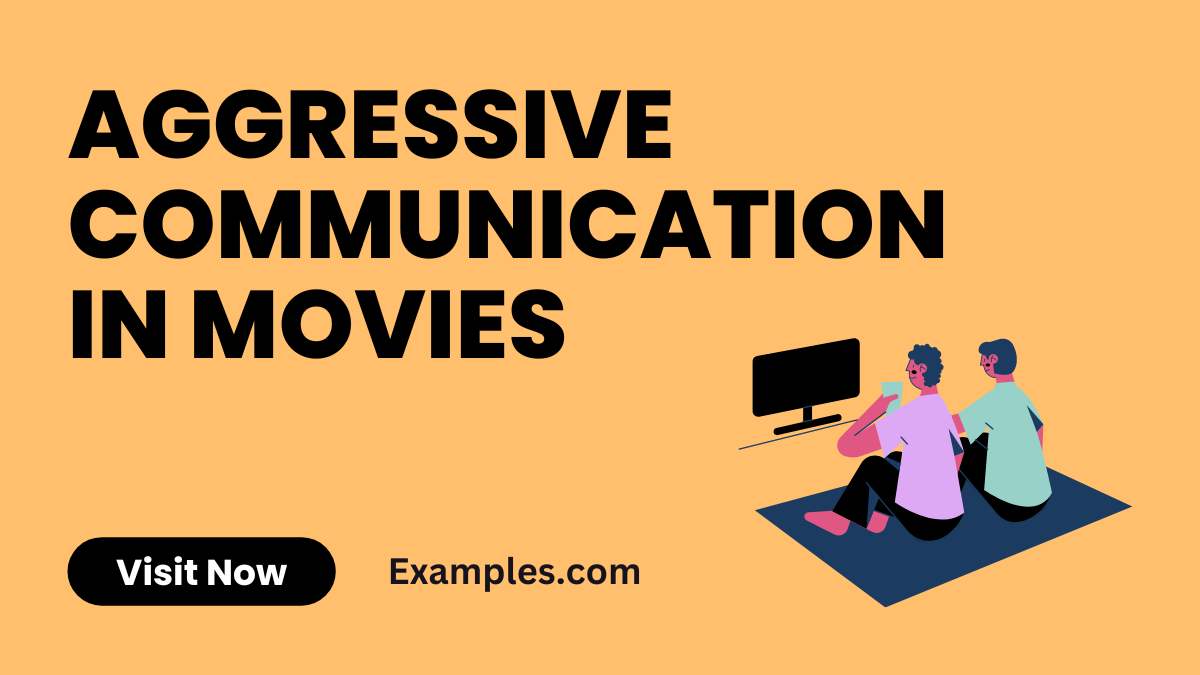14+ Aggressive Communication in Movies Examples
Aggressive communication in movies is a dynamic tool used to build tension, develop characters, and drive narratives. This guide delves into various cinematic examples where characters engage in aggressive verbal exchanges, showcasing how this technique is employed effectively. Understanding the use of passive vs. aggressive dialogue in films can enhance one’s appreciation of the nuanced art of screenwriting and character development. From explosive confrontations to subtle power plays, this exploration provides a comprehensive look at aggressive communication’s role in storytelling.
What is the Best Example of Aggressive Communication in Movies?
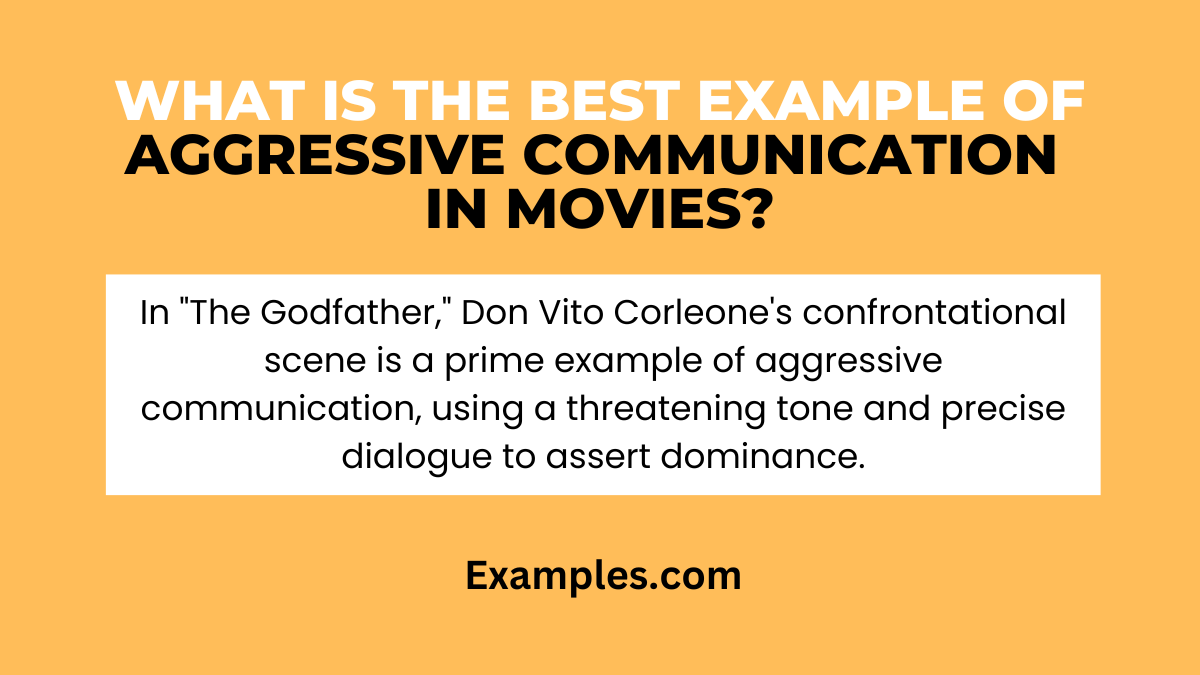
In cinematic history, one of the best examples of aggressive communication can be found in the movie “The Godfather.” The iconic scene where Don Vito Corleone confronts a rival mafia leader showcases a masterclass in using aggressive dialogue to assert power and control. The Godfather’s calm yet threatening tone, combined with his choice of words, creates an atmosphere of tension and intimidation. This scene exemplifies how aggressive communication in film can be more than just loud arguments; it’s about conveying dominance, fear, and the unspoken threat through carefully crafted dialogue and nonverbal cues. This example not only highlights the effectiveness of aggressive communication in movies but also demonstrates its impact on character development and plot advancement.
15 Aggressive Communication in Movies Examples
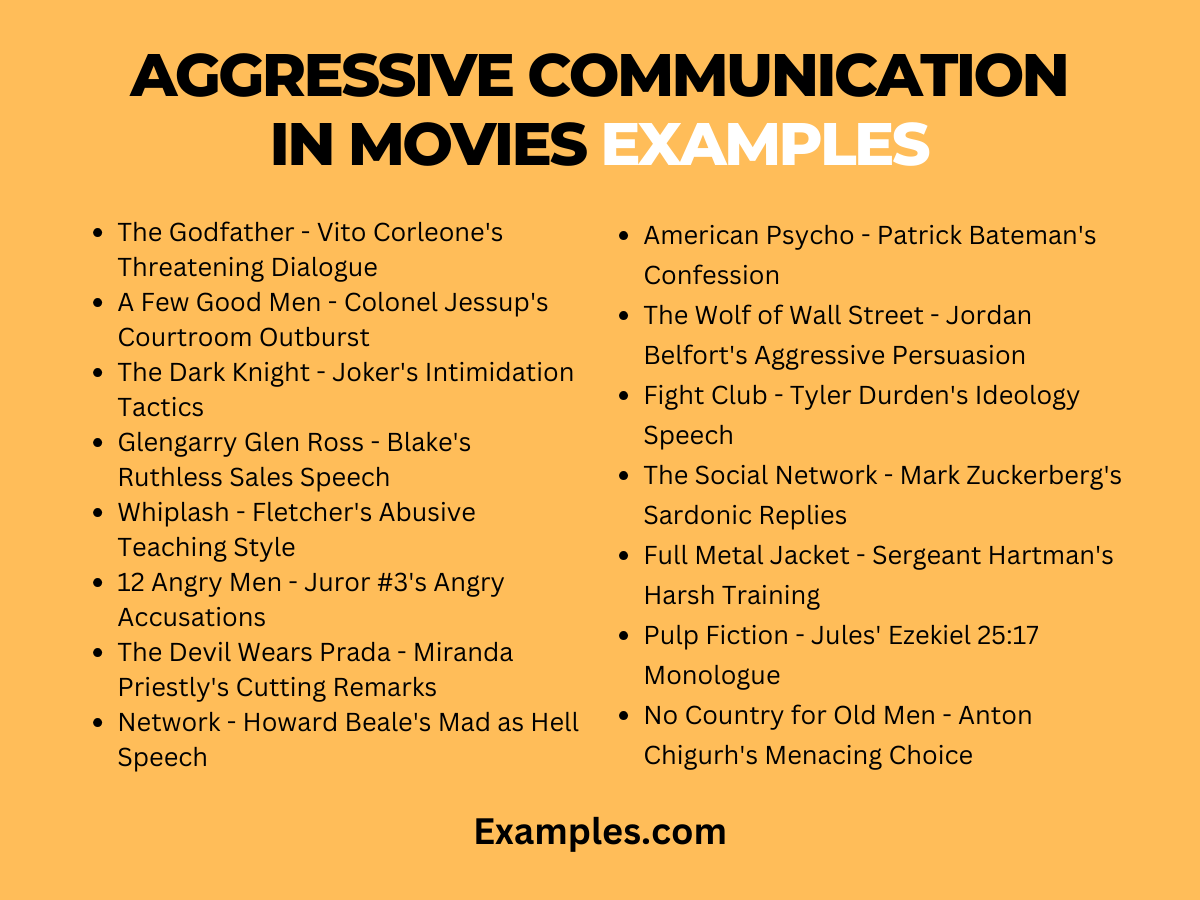
- The Godfather – Vito Corleone’s Threatening Dialogue: The Godfather uses calm yet menacing language to assert control. Example: “I’m going to make him an offer he can’t refuse.”
- A Few Good Men – Colonel Jessup’s Courtroom Outburst: An iconic scene where Jessup aggressively defends his actions. Example: “You can’t handle the truth!”
- The Dark Knight – Joker’s Intimidation Tactics: Joker uses unsettling stories and a menacing tone to instill fear. Example: “Do you want to know how I got these scars?”
- Glengarry Glen Ross – Blake’s Ruthless Sales Speech: Blake delivers a harsh, demeaning speech to motivate salesmen. Example: “Coffee’s for closers only.”
- Whiplash – Fletcher’s Abusive Teaching Style: Fletcher uses aggressive, insulting language to push his student. Example: “Not quite my tempo.”
- 12 Angry Men – Juror #3’s Angry Accusations: Heated arguments showcase aggression in decision-making. Example: “He’s guilty! I know he’s guilty!”
- The Devil Wears Prada – Miranda Priestly’s Cutting Remarks: Miranda uses passive-aggressive comments to assert dominance. Example: “That’s all.”
- Network – Howard Beale’s Mad as Hell Speech: A furious rant reflecting societal frustrations. Example: “I’m as mad as hell, and I’m not going to take this anymore!”
- American Psycho – Patrick Bateman’s Confession: A chilling, aggressive monologue revealing his true nature. Example: “I’m into, uh, well, murders and executions mostly.”
- The Wolf of Wall Street – Jordan Belfort’s Aggressive Persuasion: Uses forceful language to motivate and manipulate. Example: “Sell me this pen.”
- Fight Club – Tyler Durden’s Ideology Speech: Durden delivers aggressive rhetoric to challenge norms. Example: “You’re not your job.”
- The Social Network – Mark Zuckerberg’s Sardonic Replies: His dialogues often carry a tone of disdain and arrogance. Example: “You’re not an asshole, Mark. You’re just trying so hard to be.”
- Full Metal Jacket – Sergeant Hartman’s Harsh Training: The sergeant employs a barrage of insults and threats. Example: “What is your major malfunction?”
- Pulp Fiction – Jules’ Ezekiel 25:17 Monologue: A mix of calm narration and sudden aggression. Example: “And you will know my name is the Lord when I lay my vengeance upon thee.”
- No Country for Old Men – Anton Chigurh’s Menacing Choice: Chigurh’s cold, calculated speech instills dread. Example: “Call it, friendo.”
Aggressive Communication in Movies Different from Real Life?
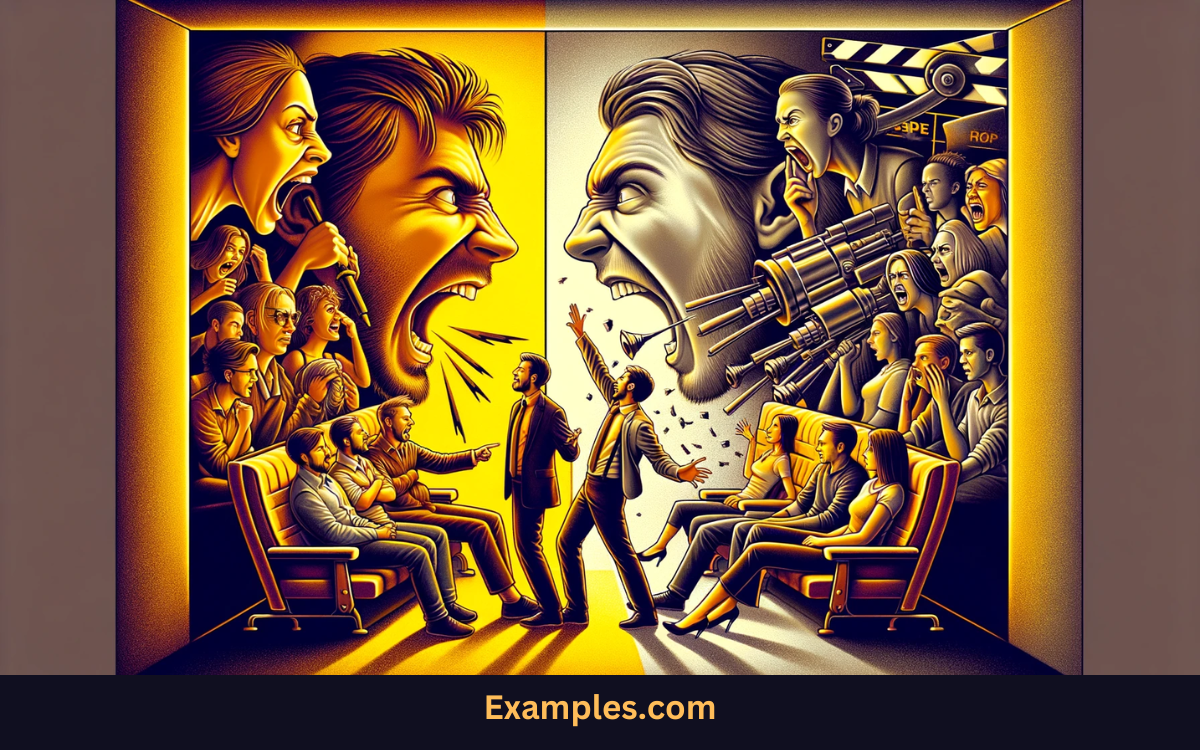
- Exaggeration for Dramatic Effect: In movies, aggressive communication is often heightened to create drama and tension. Unlike real life, where such intensity might be rare, films amplify these interactions for storytelling purposes.
- Scripted and Controlled: Unlike spontaneous real-life interactions, movie dialogues are carefully scripted. This allows for a more dramatic portrayal of aggressive communication, which is controlled and designed to serve the plot.
- Lack of Real Consequences: Movie characters often engage in aggressive behavior without the realistic consequences that would occur in real life. This can create a skewed perception of the acceptability of such communication.
- Character Development Tool: Films use aggressive communication to develop characters quickly, something that is not typically mirrored in real-life interactions. It’s a shortcut to showcase a character’s personality or transformation.
- Audience Emotional Response: Aggressive communication in movies is often used to evoke a strong emotional response from the audience, a technique not commonly seen in real-life everyday communication.
Why is Aggressive Communication Featured in Movies?
- Creating Conflict and Tension: Aggressive communication is a powerful tool to create conflict, a key element in storytelling. It adds drama and engages the audience in the narrative.
- Character Arc and Development: It helps in character development, showcasing a character’s journey from aggression to a more passive stance, or vice versa, thereby enriching the plot.
- Reflecting Societal Issues: Movies often mirror societal issues, and aggressive communication can highlight problems like power imbalances or social injustices, making it a significant communication style in films.
- Driving the Plot Forward: Aggressive interactions often lead to pivotal plot developments, propelling the story forward in ways that more passive communication might not.
- Artistic Expression: Filmmakers use aggressive communication as a form of artistic expression, to create memorable scenes and dialogue that resonate with viewers.
How Does Aggressive Communication Impact Movie Audiences?
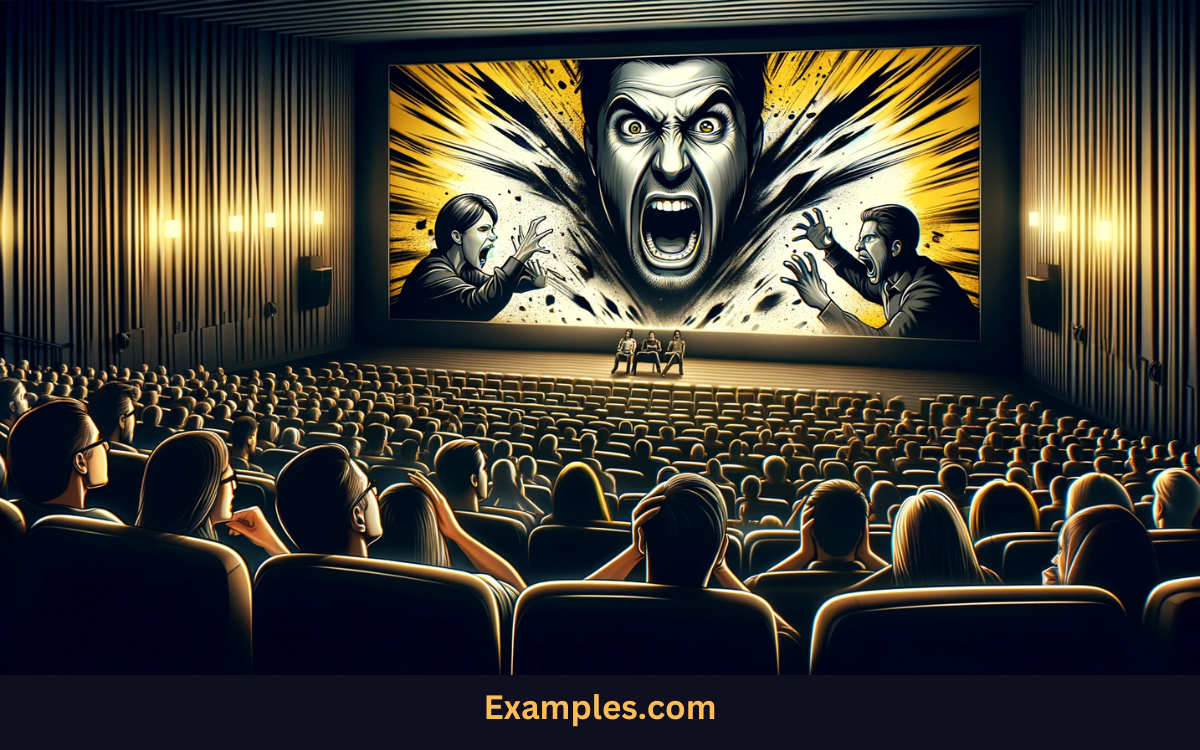
- Emotional Engagement: Aggressive communication can deeply engage audiences emotionally, making them feel connected to the characters and the story.
- Influencing Perception of Reality: Such communication can shape viewers’ perceptions about real-world interactions, sometimes normalizing aggressive behavior.
- Cathartic Experience: For some viewers, watching aggressive communication on screen can be cathartic, allowing them to experience intense emotions in a controlled environment.
- Educational Perspective: It can offer an educational perspective on the consequences and dynamics of aggression, especially when balanced with passive communication scenes.
- Reflecting on Personal Communication Styles: Observing aggressive communication in films can lead viewers to reflect on their own communication styles and possibly encourage the adoption of healthier, more effective communication methods.
In summary, this exploration of aggressive communication in movies provides a nuanced understanding of its role in cinematic storytelling. We’ve dissected how it differs from real-life communication, its purpose in film narratives, and its effect on audiences. This guide offers insights into the power of film as a medium to convey intense emotions and complex interactions, encouraging viewers to reflect critically on the impact of on-screen communication in their understanding of real-world dynamics.



